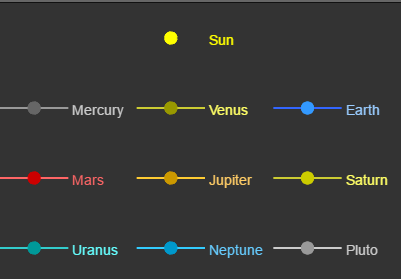An Orrery is a moving, mechanical model of the Solar System. It shows how all of the planets orbit around the Sun.
We have created an online version here, called the Electric Orrery. This tool will let you see where the planets are on any given day.
You can see where they are today, where they were in the past, and where they will be in the future.

How the Electric Orrery works?
The Electric Orrery is aligned to the Ecliptic coordinate system. A line from the Earth to the Sun would point towards the right of the screen at the spring equinox in the Northern Hemisphere.
An Orrery is often shown with the planets orbiting the Sun in an anti-clockwise direction. This is only true if you are viewing the Solar System from above the north of the Earth. We have chosen to show a different view, from above the south of the Earth. This is why the planets move in a clockwise direction in the Electric Orrery.
Please note that this Electric Orrery is written in a computer language called JavaScript. It may not work if your internet browser is not set up to run JavaScript programmes.
How to use the Electric Orrery?
The Electric Orrery has a number of controls for changing the simulation. You can change the date, look at different parts of the Solar System and move forwards and backwards in time. This is all done with the buttons on the Orrery control panel.
- Changing the Date
You can move the date forward or backwards in periods of a day, a month, or a year.
You can also move forward or backwards in time using the arrow keys at the top of the control panel.
The more arrows the faster time passes. The date you are currently viewing can be seen to the top right of the orrery.
- Viewing Different Planets
The Solar System is a very big place and Pluto is 100 times further away from the Sun than Mercury.
The Orrery draws the orbits of the planets to scale, so if Pluto is shown, then all the inner planets would be squeezed together in the middle. Therefore, you can change the display options to allow you to see a selection of the Solar System at a time.
- Inner Solar System - This view shows four terrestrial planets, with the option to show the planet names (labels).
- Visible Solar System - This option includes the planets out to Saturn. Based on what we can see with the naked eye in the night sky.
- Outer Solar System - Focuses on the four outer planets, with the option to include the dwarf planet, Pluto.
- Animating the Orrery
The Electric Orrery can animate the movement of planets over time. By clicking on the arrow buttons you will begin to animate the orrery, and will see the date changing in the top right.
You can go both forwards and backwards in time, and use the stop button to pause the orrery at any point.
There are three buttons for going forward (or backwards) at different speeds:
- > Go forward one day at a time.
- >> Go forward one month at a time.
- >>> Go forward one year at a time
- Understanding the Key
The Key shows you which planet is which on the screen. You can find out more about each of the planets and the dwarf planet, Pluto, from the Solar System section of the Learn menu.
Note that the sizes of the orbits of the planets are to scale, the planets themselves are not.
Image CreditThis work by The Schools' Observatory is licensed under All rights reserved
CreditThis work by The Schools' Observatory is licensed under All rights reservedThe key to the Electric Orrery
Start Exploring!
Now that you know how to use the Electric Orrery, you can start exploring the Solar System.
See how the planets move, discover their positions on any given day, and enjoy your journey through space!
Controls
Display
Show Labels? Show Pluto?
Inner Solar System Visible Solar System Outer Solar System
